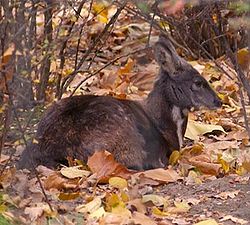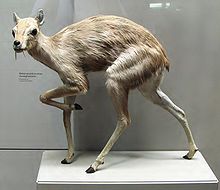- Musk deer
-
Musk deer
Temporal range: Early Miocene–Recent
Moschus moschiferus Scientific classification Kingdom: Animalia Phylum: Chordata Class: Mammalia Order: Artiodactyla Suborder: Ruminantia Infraorder: Pecora Family: Moschidae
(Gray, 1821)Genus: Moschus
(Linnaeus, 1758)Species - Moschus chrysogaster — Alpine Musk Deer
- Moschus moschiferus — Siberian Musk Deer
- Moschus berezovskii — Dwarf Musk Deer
- Moschus fuscus — Black Musk Deer
- Moschus anhuiensis — Anhui Musk Deer
- Moschus cupreus — Kashmir Musk Deer
- Moschus leucogaster — White-bellied Musk Deer
Musk deer are artiodactyls of the genus Moschus, the only genus of family Moschidae. They are more primitive than the cervids, or true deer, in not having antlers or facial glands, in having only a single pair of teats, and in possessing a gall bladder, a caudal gland, a pair of tusk-like teeth and—of particular economic importance to humans—a musk gland. Moschids live mainly in forested and alpine scrub habitats in the mountains of southern Asia, notably Himalayas. Moschids are entirely Asian in their present distribution, being extinct in Europe where the earliest musk deer are known from Oligocene deposits.
Contents
Characteristics
Musk deer resemble small deer with a stocky build, and hind legs longer than their front legs. They are approximately 80 to 100 centimetres (31 to 39 in) in length, 50 to 70 centimetres (20 to 28 in) tall at the shoulder, and weigh between 7 and 17 kilograms (15 and 37 lb). The feet of musk deer are adapted for climbing in rough terrain. Like the Chinese water deer, a cervid, they have no antlers, but the males do have enlarged upper canines, forming sabre-like tusks. The dental formula is similar to that of true deer:

The musk gland is found only in adult males. It lies in a sac located between the genitals and the umbilicus, and its secretions are most likely used to attract mates.
Musk deer are herbivores, living in hilly, forested environments, generally far from human habitation. Like true deer, they eat mainly leaves, flowers, and grasses, with some mosses and lichens. They are solitary animals, and maintain well-defined territories, which they scent mark with their caudal glands. Musk deer are generally shy, and either nocturnal, or crepuscular.
Males leave their territories during the rutting season, and compete for mates, using their tusks as weapons. Female musk deer give birth to a single fawn after about 150–180 days. The newborn young are very small, and essentially motionless for the first month of their life, a feature that helps them remain hidden from predators.[1]
Musk deers have been hunted for their scent glands which can fetch up to $45,000/kg on the black market. It is rumored that ancient royalty wore the scent of the musk deer and that it is an aphrodisiac.[2]
Evolution
 Reconstruction of the extinct genus Micromeryx
Reconstruction of the extinct genus Micromeryx
Musk deer may be a surviving representative of the Palaeomerycidae, a family of ruminants that is probably ancestral to deer. They first appeared in the early Oligocene epoch and disappeared in the Pliocene. Most species lacked antlers, though some were found in later species. The musk deer are however still placed in a separate family.
References
External links
- Guha S, Goyal SP, Kashyap VK (March 2007). "Molecular phylogeny of musk deer: a genomic view with mitochondrial 16S rRNA and cytochrome b gene". Mol. Phylogenet. Evol. 42 (3): 585–97. doi:10.1016/j.ympev.2006.06.020. PMID 17158073. http://linkinghub.elsevier.com/retrieve/pii/S1055-7903(06)00265-X.
- Hassanin A, Douzery EJ (April 2003). "Molecular and morphological phylogenies of ruminantia and the alternative position of the moschidae". Syst. Biol. 52 (2): 206–28. doi:10.1080/10635150390192726. PMID 12746147. http://sysbio.oxfordjournals.org/cgi/pmidlookup?view=long&pmid=12746147.
Categories:- Musk deer
- Even-toed ungulates
- Fauna of Pakistan
Wikimedia Foundation. 2010.
